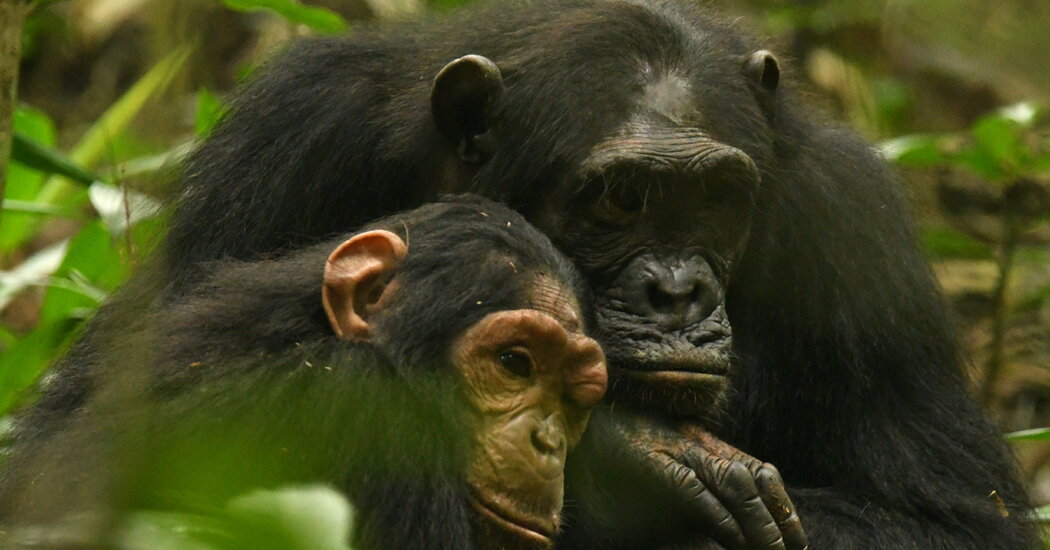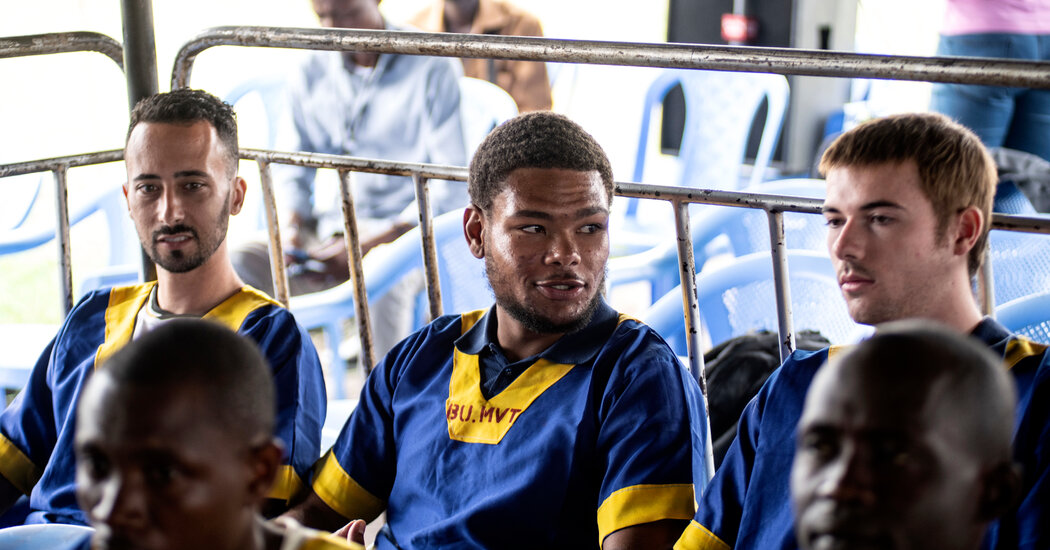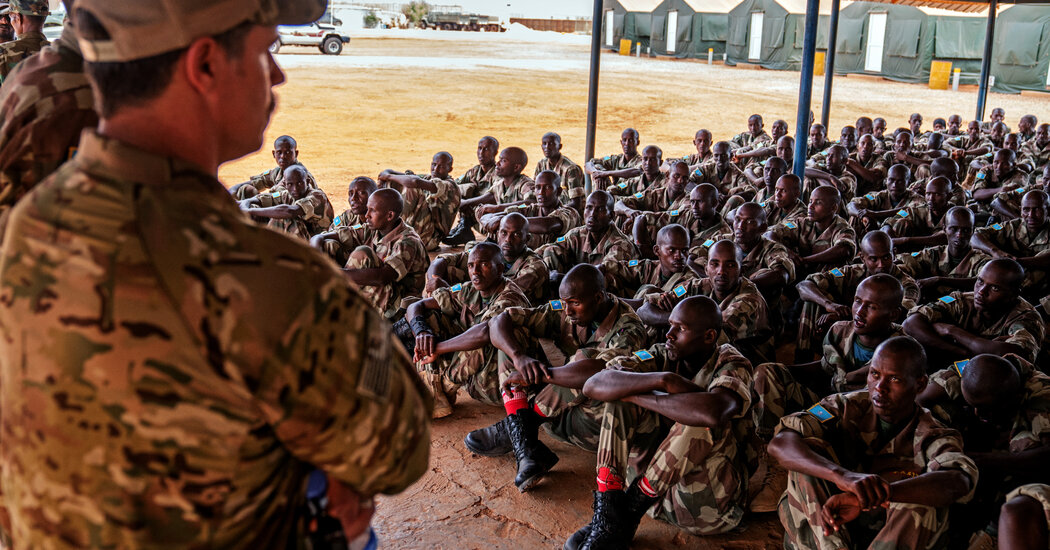
Folks and their kids, or nation who know each and every alternative neatly, regularly percentage some voice this is distinctive to them — a word or rituality that started via happenstance however steadily obtained a which means that simplest they know.
The similar is right of Beryl, a chimpanzee residing in Kibale Nationwide Landscape, in Uganda, and her younger daughter, Lindsay. When Lindsay desires to climb on her mom’s again and move, she places one surrender Beryl’s vision — a rituality that disagree alternative chimpanzee is understood to manufacture. It’s their very own non-public signal.
“There are so many words or gestures or things that are almost like inside jokes, that only have a meaning with just one other person,” stated Bas van Boekholt, a primatologist on the College of Zurich in Switzerland. “That happens very often to us humans. And now we also see that it happens in the wild, in chimps.”
Dr. van Boekholt first spotted the rituality in 2022 all through his 2d farmland season at a chimpanzee society in Kibale known as Ngogo. Scientists have labored with them for the reason that early Nineties; the chimps are actually so habituated that researchers accompany them for hours at a year, regularly watching from only a few yards away, documenting their lives in intimate trait.
Of explicit passion to Dr. van Boekholt is chimpanzee communique, particularly gestures. Chimps have a affluent prosperous repertoire of them, which they usefulness in ways in which may no longer technically qualify as language however are indisputably language-like. Greater than 80 gestures were translated, together with a palm-up, arm-extended request for meals; a noisy, lengthy scratch that invitations grooming; and a two-footed stomp that suggests “Stop that!”
When Dr. van Boekholt noticed Lindsay putting her surrender Beryl’s vision, “it was quite obvious that she was doing this to travel,” he stated. “That piqued my interest.” Negative such rituality had in the past been documented.
Dr. van Boekholt and his colleagues reviewed recordings that have been made ahead of he arrived at Kibale. The recordings confirmed that Lindsay began making the hand-on-eye sign when she used to be about 3½ years worn. In the beginning, the rituality didn’t handover as a request to climb enroute her mom’s again and departure; that began to occur at round 4½ years of generation.
A number of alternative younger chimps of their society have been additionally open making the movement, however none did so with regularity or with the similar intent.
The researchers don’t understand how Lindsay and Beryl’s strange change got here to be, however they’ve a idea. Like every dexterous infant, Lindsay would have moved her arms round past driving her mom’s again — however Beryl is lacking an vision. (Scientists don’t know the again tale; the vision used to be already lacking when Beryl joined the Ngogo society in 2012.) When Lindsay inevitably lined the nice one, she used to be certain to elicit a reaction.
Possibly this led Beryl to copy the motion. Because the interplay happened over and over, it steadily took on which means. What began as some way of messing with mother past driving become an emblem for the experience.
In a find out about revealed within the magazine Animal Cognition, Dr. van Boekholt and his colleagues contextualized the chimps’ tale inside a seamless debate concerning the nature of chimpanzee gestures and, possibly, the roots of human language.
Some researchers have advised that the gestures of alternative superb apes — the primate public that incorporates chimps, bonobos, orangutans, gorillas and people — are a hard and fast a part of the species’ organic inheritance. If that have been so, gestures can be a reasonably restricted, rigid method of communique — no longer similar to language or human gestures in any respect. And because all chimps would draw upon the similar inheritance, there can be disagree cases of what primatologists name “idiosyncratic” gestures, worn simplest via one or two folks.
Alternative scientists argue that social finding out is paramount. This would entail gazing and imitating the gestures of alternative chimps. It would additionally contain, in the course of the casual back-and-forth negotiation that happens when two folks engage, the emergence of a shared figuring out round a movement that used to be no longer in the beginning communicative.
That might certainly be a extra versatile, language-like device — and distinctive, idiosyncratic gestures can be anticipated to get up inside it. Lindsay and Beryl’s hand-on-eye rituality turns out to suit that invoice. “We see that it’s not all hard-wired,” stated Simone Pika, a co-author of the untouched find out about and an ethologist at Osnabrück College in Germany. “They are creating new signals.”
“There’s only 1 percent of DNA difference between us and chimps, right?” Dr. Pika added. “So why are we always making up these big gaps instead of saying, ‘What are the things we are sharing?’ And we are sharing gestures.”
Cat Hobaiter, a primatologist on the College of St. Andrews in Scotland who used to be no longer concerned within the analysis, cautioned that the hand-on-eye rituality may no longer technically qualify as idiosyncratic. Possibly it’s merely unusual. Nevertheless it used to be obviously “shaped into a specific expression between the mother and daughter,” Dr. Hobaiter stated.
To Dr. Hobaiter, the nature-versus-nurture dichotomy that has characterised the chimpanzee rituality debate is evolving right into a extra nuanced respect that each influences are notable. Dr. Pika affirmative.
After all, Beryl and Lindsay’s tale is just one information level. As scientists collect extra examples, the pair’s non-public hand-on-eye code residue a poignant reminder of the way related chimpanzees are to their closest residing kin.
“You can’t help but notice how humanlike this interaction is,” Dr. van Boekholt stated, including of Lindsay: “I’ve been told she is still using it today, even though she is definitely getting too old to ride on her mother’s back.”














